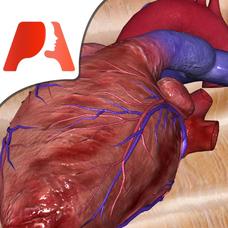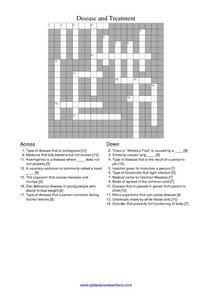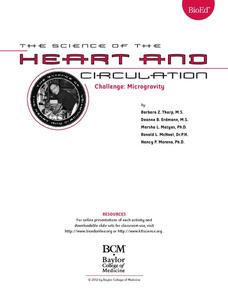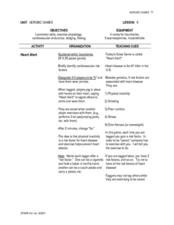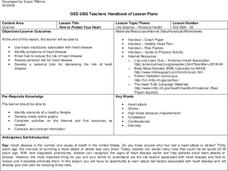Pocket Anatomy
Pocket Heart
An all-encompassing, fully interactive, gorgeously animated model of the heart can be used to teach cardiac anatomy, physiology, and even a touch of epidemiology.
Baylor College
Examining the Heart
Break hearts with this lesson plan: chicken or sheep hearts, that is! Your class examines the external and internal structure of the heart with a dissection activity. A handy anatomy resource provides the necessary materials for...
Curated OER
You Gotta Have Heart: Congenital Heart Defects and Heart Surgery
Assess anatomists' understanding of the structure of the mammalian heart by giving a pretest. Have them visit some websites to further learn about heart anatomy. Then take them into the laboratory to perform a dissection so that they get...
Teach Engineering
Model Heart Valves
Small groups use the knowledge learned about the heart to design and build a prototype of an artificial heart valve. The teams demonstrate the functionality of their valve. They are also responsible for creating a pamphlet that describes...
Baylor College
Heart Rate and Exercise
Teach your exercise enthusiasts to read their pulse rate at the radial artery and multiply by four to calculate beats per minute. Learners perform a variety of activities, recording their heart rates after one minute of each. Though...
Baylor College
The Heart is a Pump
Circulate this news: the heart is a pump containing one-way valves! Following the previous lesson on the external structure of the heart, learners now take a look at the inside. They use a three-color diagram to label a black-and-white...
Baylor College
It Begins with the Heart
Aspiring anatomists label a photograph of a human heart by comparing it to a colored diagram on the same page. The video that is mentioned in the procedure does not seem to be available, but the overview provides plentiful background...
Baylor College
Heart and Circulation: Pre- and Post-Assessments
Middle schoolers demonstrate what they know about the structure and function of the heart and blood vessels. A set of 15 multiple-choice questions also addresses how the heart handles microgravity and how animals without...
Teach Engineering
Heart to Heart
Begin a unit on the heart, the parts and the function of the heart, and about heart disease with a resource that includes a lecture, a PowerPoint presentation, and research information. The lesson is the first of a four-part series...
Teach Engineering
The Mighty Heart
Have your class follow the step-by-step directions in this resource to dissect a sheep heart and gain a better understanding of this amazing organ. Working in small groups, pupils look for specific parts of the heart during their...
Curated OER
Disease And Treatment
In this Disease and treatment worksheet, students solve 17 clues in a crossword puzzle about types of diseases, types of micro-organisms and immune system cells.
Baylor College
Why Circulate?
Lub-dub, lub-dub. Why does the heart beat? Why does blood circulate throughout the body? Life scientists find out how important circulation is for dissolving and dispersing materials by timing how long it takes for food coloring spread...
Baylor College
Challenge: Microgravity
What a festive way to examine what happens to the heart in different gravitational situations! Small groups place a water-filled balloon in different locations (on a table top, in a tub of water, and held in a vertical position), drawing...
Curated OER
Heart Alert
Explore some of the causes and preventions of heart disease. Young learners play a game of tag in which the taggers role play as risk factors for heart disease. Players who are tagged call out "heart alert" and are saved when someone...
Curated OER
The Heart Stopper
Use the pump from a spray bottle to drive a model of the heart in action! In addition to modeling the function of the heart and blood vessels, aspiring anatomists also simulate arterial blockage. They compare the effects of increased...
Curated OER
Keeping Your Heart in Good Shape: What are the Benefits? - Biology Teaching Thesis
Middle schoolers name the main parts of the heart and what events occur there. They write a reaction that contains complete sentences, and uses proper spelling and grammar, after viewing a video. Students define the following terms:...
Curated OER
Here's To Your Healthy Heart!
Learners examine the primary controllable and uncontrollable factors that put one at greater risk for developing heart disease. Through discussion, research, physical tests, and questionnaires they determine whether or not they are at...
Curated OER
Human Body Series - Cardiovascular System
Pump up your class while studying the cardiovascular system with this pair of activities. In one, learners record heart rates during different actions. In the second, they read kid-friendly heart health articles online and then write a...
Curated OER
How to Protect Your Heart
Students examine risk factors associated with heart disease and develop their own personal plans for decreasing the risk of heart disease.
Curated OER
Have a Heart!
Learners assume the role of a doctor, detective, and decision maker. They research the function of the heart, the diseases associated with the heart, and lifestyle choices that are heart healthy. Information gathered will be placed in a ...
K12 Reader
Character Development in "The Tell-Tale Heart"
Yes. Make up your mind to use this reading comprehension resource with your readers. You need not be nervous, not even a little nervous. An answer sheet is provided.
Curated OER
Heart 2: Changing Lifestyles and Heart Health
Young scholars examine and evaluate changes in diet and lifestyle from prehistoric to modern times and how these differences have spurred the development (and better treatment) of heart disease.
Curated OER
Heart 1: Transplant
High schoolers explain the workings and anatomy of the heart and to explore new medical techniques that help people live longer, healthier lives.
Curated OER
Signs and Symptoms and Others of a Heart Attack or Congestive Heart Failure
In this health worksheet, students find the words that describe the signs and symptoms of a heart attack. The answers are found at the bottom of the page.


